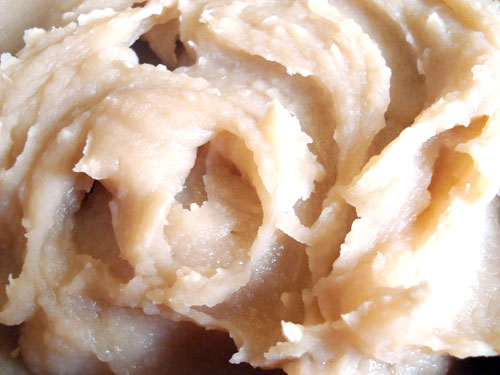
Usually when I put a recipe up here, it's something that's been fully resolved: that is, I've tried it out for myself (in most cases several times over), and I know that it works. This one is a bit different, but I thought I'd write about it in-progress, as it were, anyway.
Filed under:
legumes vegetarian vegan
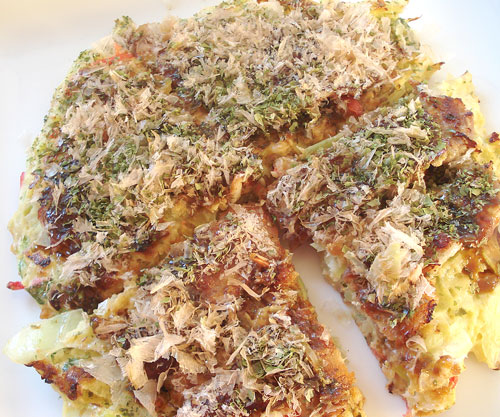
Okonomiyaki is getting slowly more popular outside of Japan. It's often described as a Japanese pizza, but it's more like a savory pancake.
Okonomiyaki was invented, they say, in Osaka, which is a city famous for cheap and good eats. Okonomiyaki is a snack more than a full meal, though it is pretty filling. It's a quintessential yatai or streetside food stand food, though nowadays you're more likely to eat it indoors than sitting at an outside stall. It's a very communal type of food, especially if you cook it on a tabletop griddle.
This is a fairly authentic recipe I think, or as authentic as a Tokyo born-and-bred girl can get.
Filed under:
japanese party food
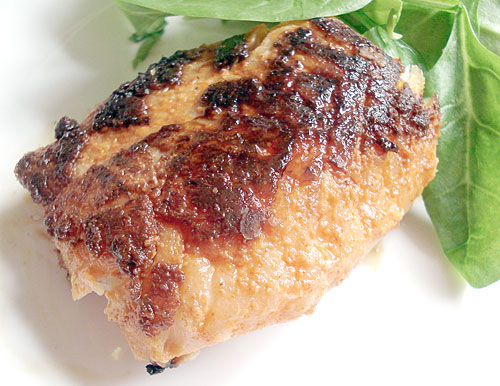
I have not featured many fish recipes here on Just Hungry. This is because at the moment I live in a landlocked country, where sea fish must be shipped in, and is expensive to boot. When I do buy some fish, I savor it as a treat. (I may be preparing myself for something that all fish eating people might have to endure soon, given the problems of overfishing.)
This is a classic miso marinade with a spicy twist. Instead of using just miso, I've added a little bit of kochujang, spicy Korean bean paste. I've used cod for this, but you could use any firm, flaky white fish instead - or even an oily fish such as salmon or swordfish. The pieces of fish should have a certain thickness, so thin fish like flounder won't do.
Filed under:
japanese lighter fish
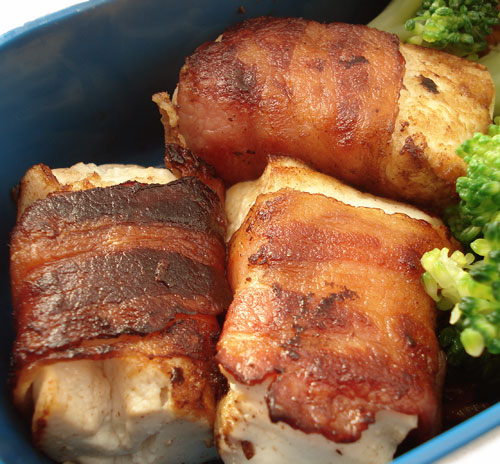
Bacon. Tofu. Two proteins on the opposite ends of the food social scale. One is revered, serenaded, hailed as the food of the Gods. The other is reviled, sneered at, as being bland, boring, even disgusting.
When I saw this conflict depicted as bendable figurines (via Serious Eats) I had to do something to end this conflict.
The only reason why tofu is put down is because of its mishandling by well meaning but unskilled cooks who focused only on its healthy benefits. There are plenty of Westerners who hate tofu, but you'd be hard put to find many Asians who do. That is becase in eastern Asian cuisines, tofu is infused with other flavors, as it should be.
So, back to the bacon and tofu. This is actually not an uncommon dish in Japanese households. It's called either just bacon tofu (or tofu bacon) or even bacon tofu steak. The salty bacon-ness of the bacon infuses the bland tofu, and the two marry together to become a tasty morsel that's good hot or cold. It's salty-crispy on the outside, soft on the inside. (Yes, it's good for bento, and it will feature in one shortly.)
Filed under:
japanese tofu bacon
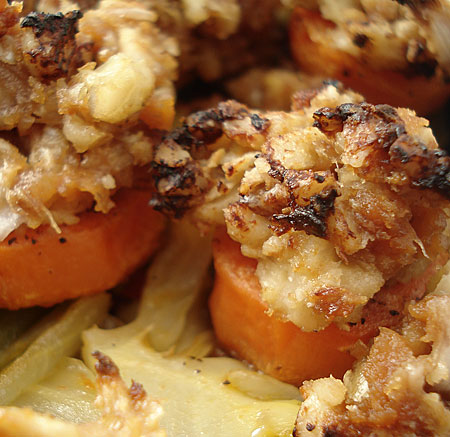
I know that a lot more people read Just Hungry than read Just Bento (and I know a lot read both - thank you!) Most recipes are posted here, but when there is a recipe that works especially well in a bento lunch, I post it on the bento site.
These miso-tahini-walnut topped baked carrots are great for bento, but are really even nicer warm out of the oven. And I think the world needs more tasty vegan protein recipes. So in case you don't read Just Bento, but you are vegetarian/vegan (and this is dairy free and all that, could be made gluten-free quite easily by choosing the right miso...only nut allergy people wouldn't benefit) head on over to Just Bento and check it out. Another one that is very bento-suitable that you might like is _shio kombu_ or kombu no tsukudani, kombu seaweed cooked in soy sauce...I know several people have asked me for a recipe...well, there it is, right there!
Filed under:
japanese nuts vegan
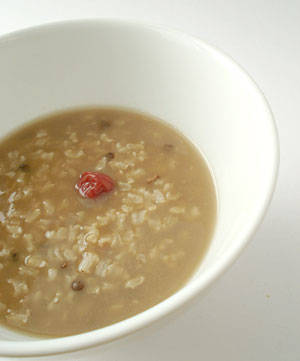 A traditional custom in Japan is to eat nanakusa gayu, or seven greens rice porridge, after the New Year's feasting period, to rest the stomach and bring the body back into balance. At any time of the year, kayu or okayu are eaten when the body is weakened by sickness, fatigue or overeating.
A traditional custom in Japan is to eat nanakusa gayu, or seven greens rice porridge, after the New Year's feasting period, to rest the stomach and bring the body back into balance. At any time of the year, kayu or okayu are eaten when the body is weakened by sickness, fatigue or overeating.
Chagayu or tea rice porridge is a speciality of the ancient city of Nara and the surrounding area. (Nara was briefly the capital of Japan in the 7th century, and is one of the most historical cities in the country). Chagayu is usually made with white rice, but I used brown rice (genmai) instead, plus a small amount of firm green puy lentils from France. The lentils are not traditional, but I like the contrasting texture.
This has been my breakfast for about a week now. It's not in the same category as eggs and bacon or a stack of pancakes, but I find my body needs something like this sometimes to bring it back into balance. It's filling and warming, yet feels very cleansing to the body. A cup of this has less than 100 calories, and is high in fiber.
Filed under:
japanese lighter rice tea vegan
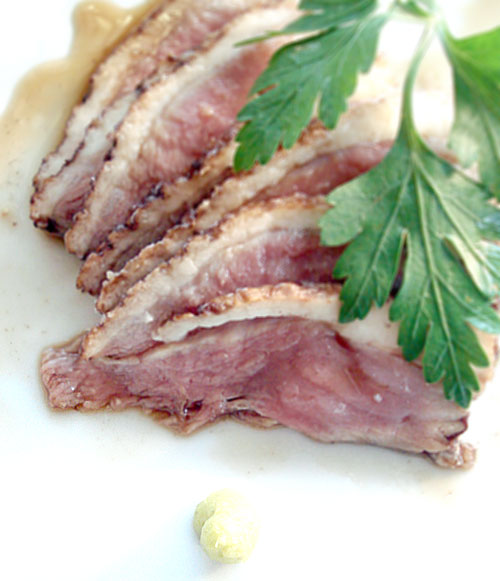
I had to make this beautifully easy duck breast dish three times over within a span of two weeks. The first two attempts disppeared before I could take a photo.
Filed under:
books and media japanese tv duck meat
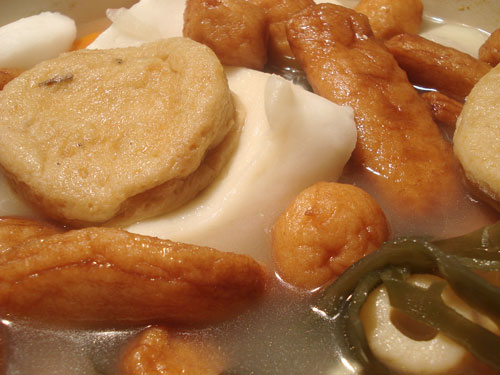
Happy New Year! If you live in Japan, you are probably still in holiday mode. Elsewhere though, chances are you're back to your normal routine. That's where I am now - back to work!
I often get requests for various popular Japanese recipes. I keep on thinking I've written up so many of them already, until someone asks for one and I think "why didn't I put that up already?". One such recipe is for oden, a very popular Japanese stew dish that is especially suited to winter. Traditionaly it's made in a donabe or pottery pot, but it's not a requirement to use one. It's simmered slowly, so is perfect for a crockpot or my favorite for stewing anything, a Le Creuset-type of cast iron enamelled pot.
[adsense:468x60:1:4]
Filed under:
japanese winter fish slowcook
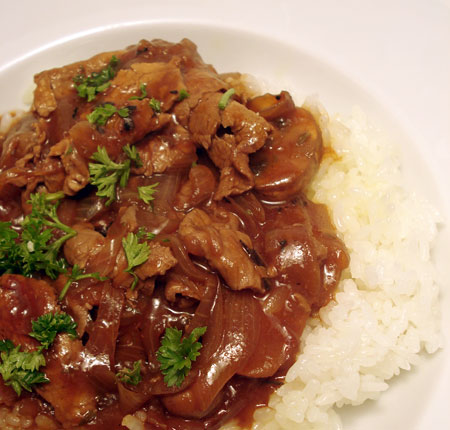
Hayashi raisu or hayashi rice is a Japanese version of a rich beef stew. It's a classic _yohshoku_ (Japanese-adapted Western food) dish.
Filed under:
japanese winter yohshoku beef slowcook meat
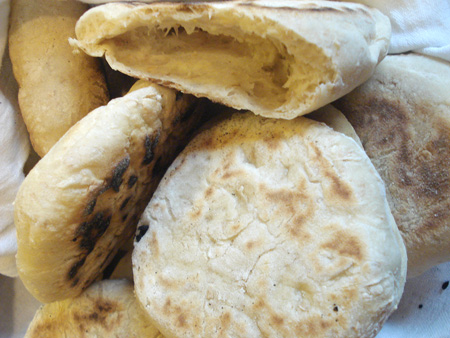
Even with more than 900 (and counting) posts and almost 200 recipes posted on Just Hungry, there are still lots of things that I make all the time, but haven't got around to writing about yet. A lot of those things take more time to write up than cook, almost. This whole wheat pita bread recipe is one of them. You do have to account for the obligatory rising time for the dough, but otherwise it's dead easy, and your kitchen working time in total is maybe 20 minutes, 30 tops. For fresh baked bread!
The key is that the pitas are not baked in the oven. No need for preheating baking stones or quarry tiles or all that stuff. They are baked, so to speak, in a plain old frying pan. You can make them any size you want as long as it fits in the bottom of the frying pan. I like to make small, palm-sized ones for easy snacking or bringing along for lunch.
This recipe also only requires 3 cups of flour in total. I sometimes get a bit frustrated by bread recipes that call for like 6 cups of flour, since we are a small household watching our collective waistlines and there's no way we can eat that much bread in a reasonable amount of time. Sure you can freeze the excess, but then you can quickly accumulate massive amounts of frozen bread if you bake often. So anyway, this makes 12 smallish pitas, which are gone quite quickly, especially with a resident Bread Fiend in house.
I referred to many other pita bread recipes, especially this excellent one on About.com, before arriving at this version. The cooking in the frying pan concept came from watching naan bread and Chinese flat breads puff when cooked on griddles. A griddle is not necessary though - and I think most people have at least one frying pan.
Filed under:
bread baking favorites
Pages